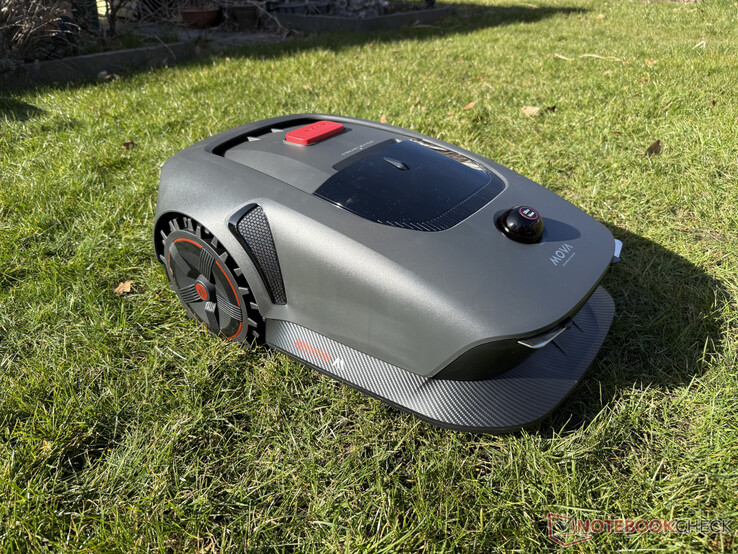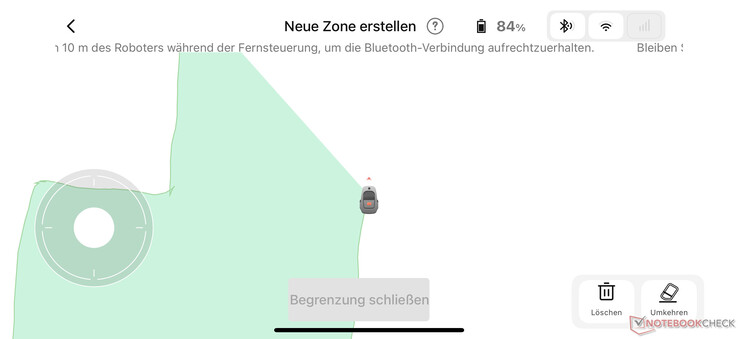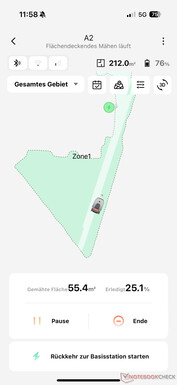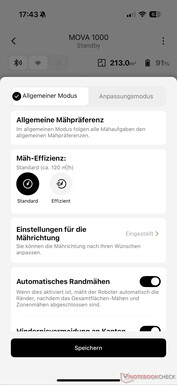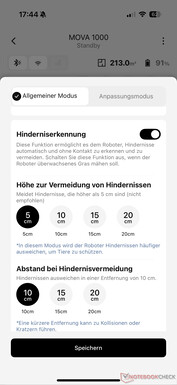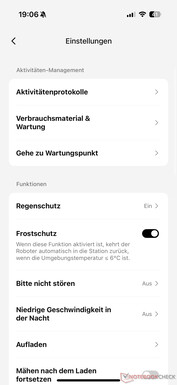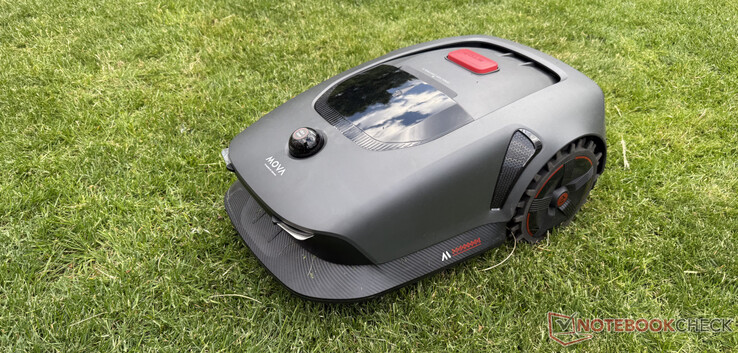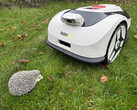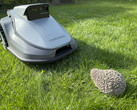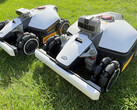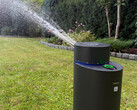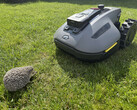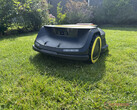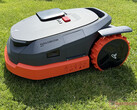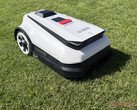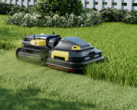Little brother of the Dreame A1 (Pro): Inexpensive LiDAR robot mower Mova 1000 in the test
Marcus Schwarten, 👁 Marcus Schwarten, ✓ Brian Burriston (translated by DeepL / Ninh Duy) Published 🇩🇪 🇫🇷 ...
Verdict: Good robotic lawnmower at a low price
The Mova 1000 performed well overall in the test. It performed solidly or better in many areas and did not fail anywhere.
Obstacle detection and navigation are solid, but not at the top level. However, this is not to be expected given the low price and limited technical features. The mowing performance, including edge mowing, is on a par with many other models. The Mova 1000 scored points in the test in narrow areas, among other things.
Overall, we believe that the Mova 1000 made a better debut than Dreame did with the A1 last year. However, this is hardly surprising, as many of Mova's technologies (which have since been further developed) are based on those of its parent company Dreame.
If you are looking for an inexpensive robotic lawnmower for smaller gardens, the Mova 1000 is a good representative without an RTK antenna at a reasonable price. Alternatives include the Eufy E15 (1,499 euros on Amazon) or the Navimow i105E / i108E (approx. 840 euros on Amazon).
Pros
Cons
Price and availability
The recommended retail price for the Mova 1000 we tested is 1,199 Euros (~$1349), and 999 Euros for the Mova 600. They are already available for less in the shops. At the time of publication of our test, the Mova 1000 only cost 999 Euros (~$1124), e.g. on Amazon.
Table of Contents
- Verdict: Good robotic lawnmower at a low price
- Features and scope of delivery: strongly reminiscent of the Dreame A1 (Pro)
- Setup and maintenance: No automatic mapping
- App and operation: Also strongly reminiscent of Dreame
- Navigation and obstacle detection: Better than the Dreame A1 back then
- Mowing performance and edge cutting: Surprising test results
- Running time and volume: Mova 1000 charges particularly quickly
- Mova 1000 in brief: Affordable LiDAR robotic lawnmower for smaller gardens
Mova, a Dreame brand, has been making increasing inroads into the market for some time now. In addition to various vacuum robots, the manufacturer also offers two Robotic mowers without a boundary wire for the 2025 gardening season: Mova 600 and Mova 1000.
We took a closer look at the Mova 1000, which differs from the Mova 600 primarily in terms of its area coverage of up to 1,000 square meters (~1200 sq yards) and is very similar to the Dreame A1 (1,299 Euros/~$1462 on Amazon) from 2024 and its improved version Dreame A1 Pro (1,399 Euros/~$1575 on Amazon) from this year. Our Mova 1000 test reveals how well the inexpensive robotic lawnmower works without a perimeter wire and what it offers.
Data sheet Mova 600 and 1000 and comparison with Dreame A1
| Property/model | Mova 1000 | Mova 600 | Dreame A1 |
|---|---|---|---|
| Area | 1,000 m² | 600 m² | 2,000 m² |
| Navigation and obstacle detection | UltraView 3D-LiDAR | UltraView 3D-LiDAR | OmniSense 3D-LiDAR |
| Mower | Mowing disk | Mowing disk | Mowing disk |
| Number of blades | 3 | 3 | 3 |
| Cutting width | 20 cm | 20 cm | 22 cm |
| Cutting height | 2 - 6 cm | 2 - 6 cm | 3 - 7 cm |
| Adjusting the cutting height | manual | manual | electric |
| Slope | 45% / 24° | 45% / 24° | 50% / 26.5° |
| Display | no | no | yes |
| Battery capacity | 2.5 Ah | 2.5 Ah | 5Ah |
| Weight | 11.7 kg | 10 kg | 12 kg |
| Dimensions | 64.3 x 41.9 x 27.9 cm | 64.3 x 41.9 x 27.9 cm | 64.3 cm x 43.7.0 x 26.1 cm |
| Water resistance | IPX6 | IPX6 | IPX6 |
| Garage included | no | no | no |
| Number of blades included | 3 + 9 | 3 + 9 | 3 + 9 |
| Color | Grey | Grey | Silver |
| RRP (at launch) | 1,199 euros | 999 euros | 1,999 euros |
Features and scope of delivery: strongly reminiscent of the Dreame A1 (Pro)
Visually, the two new Mova robotic lawnmowers are very similar to the Dreame A1 (Pro). There are also some parallels in terms of equipment. For example, Mova also relies on a pure 3D LiDAR system in the 600 and 1000. This worked well in terms of navigation, in our test of the Dreame A1 last year, but revealed weaknesses in obstacle detection.
Not surprisingly, Dreame has installed a front camera in this year's A2 (2,299 Euros/~$2587 on Amazon), which worked well in our test. The Mova 1000 does not have one. In the Mova 1000 robotic lawnmower test below, we reveal whether it can still impress when it comes to detecting obstacles, which has also improved in the Dreame A1 over time thanks to firmware updates.
Compared to the Dreame A1, however, Mova has cut corners and saved on various things. After all, the recommended retail price is only around half the price. Starting with the battery, which is only half the size. The battery life of the two Mova robotic lawnmowers is identical. However, the Mova 1000 charges around twice as fast and is therefore back on the lawn more quickly.
With an area of 1,000 square meters (Mova 1000/~1200 sq yards/~quarter acre) and 600 square meters (Mova 600/~718 sq yards), these inexpensive wireless robot mowers are aimed at owners of smaller gardens. In line with this, the cutting width of the floating mowing disc with three blades is slightly smaller than the A1 at 20 cm (~8 inches). The cutting height can be manually adjusted between 2 and 6 cm (~1 and 2.4 inches).
Setup and maintenance: No automatic mapping
Before it starts mowing, the robot lawn mower establishes the usual connection with the smartphone and the home Wi-Fi. The process is identical to Dreame and worked without any problems in the test.
As is usually the case with wireless robotic lawn mowers, the lawn must first be circled once to create a virtual map. Mova does not offer an automatic AI function, so it has to be controlled using a joystick on the smartphone display.
This worked well, as the robot can be maneuvered sensitively and does not react too frantically. Before it can start, it takes a little time out to get its bearings, which indicates that the processor is not particularly fast.
If the charging station is outside the mowing area, which can also be divided into two maps or zones, a path must also be created to get there. The same applies to connecting routes between different lawns. Here, the Mova app hiccuped once in the test and aborted the setup process with an error message, so that the entire mapping process had to be restarted.
A garage like the Eufy E15 / E18 (from 1,499 Euros/~$1687 on Amazon) is not included with the Mova 1000. However, nine replacement blades are included in the scope of delivery - in addition to the usual accessories for installation. The regularly recommended blade change requires a screwdriver. The 3D LiDAR unit on the top of the robot cleans itself using a brush in the station. The rest can be done with a garden hose thanks to IPX6 protection.
App and operation: Also strongly reminiscent of Dreame
Anyone who has already used the Dreame app will quickly find their way around the Mova app, which is virtually identical in design. On the start page of the device entry, you can see the map in the center. The live progress is also displayed here during mowing.
At the top, the Mova app provides information about the area already mowed and the battery status as well as Bluetooth, Wi-Fi and optional 4G reception if the Dreame Link module (249 Euros/~$280 at MediaMarkt) has been retrofitted.
Below this is a drop-down menu for selecting the area to be mowed and a series of buttons. They can be used to schedule automatic mowing, manage and edit up to two maps (e.g. exclusion zones), change the mowing settings and view a 3D LiDAR image of your own garden.
The mowing efficiency (standard, efficient) and the mowing direction can be set via the app. Automatic edge mowing (at the end) and obstacle avoidance at the edges can also be switched on and off. If the latter is deactivated, this ensures significantly better edge mowing. However, the robotic lawnmower then only reacts to bumper contact and otherwise drives forward mercilessly, for example through plants hanging out of adjacent beds.
The obstacle detection function can also be switched on and off. The height for obstacle avoidance (5, 10, 15 and 20 cm/~2, 4, 6 and 8 in) and the distance for obstacle avoidance (10, 15 and 20 cm) are available as options. This allows the user to decide how sensitively the Mova 1000 should react to obstacles and the safety distance at which it should drive around them. This is practical for taller grass, for example, which it would otherwise avoid. Different mowing patterns (cross or checkerboard pattern) can also be selected.
The settings menu includes activity logs, a range of options for rain, frost and animal protection, an anti-theft alarm, firmware updates and more. Overall, the Mova app is comprehensive and sophisticated, just as you would expect from Dreame. Apart from the app crashing once, as described above in the Setup and maintenance section, we only noticed a few translation mistakes but no other issues.
The cutting height is adjusted by hand between 2 and 6 cm (~1 and 2.4 in). There is no display under the removable cover on the top of the appliance. Four buttons for the basic functions are also hidden there.
Navigation and obstacle detection: Better than the Dreame A1 back then
Mova only relies on a 3D LiDAR system called UltraView for its two robotic lawnmowers, as was the case in the Dreame A1. In practice, it made a solid impression overall when navigating across our two test areas.
The navigation was largely systematic, only occasionally appearing somewhat chaotic. The power transmission of the coarse-tread wheels is quite smooth, which leads to slow movements and thus reduces the risk of digging in and leaving tracks in the lawn.
The obstacle detection on the "role model" Dreame A1 was in our test last year the biggest point of criticism. However, Dreame has since made improvements here with a firmware update. The Mova 1000 does a better job right from the start than last year's A1, so it probably benefits from the further developments at Dreame.
In the test, the Mova 1000 reliably detected the majority of our obstacles with the 5 cm obstacle height and 10 cm distance settings (~2 and 4 in) and avoided them relatively closely. In addition to the realistic-looking hedgehog dummy, these included footballs and handballs. Only a piece of garden hose lying on the lawn and a tennis ball were always run over. All in all, Mova doesn't do a perfect job, but for a robot mower without a camera, it does a solid job.
Mowing performance and edge cutting: Surprising test results
The mowing performance of the Mova 1000 was more than satisfactory in the test. It covered most of the test areas. The mowing pattern is good and typical for robotic lawn mowers with a cutting disc and three blades. As the mower is relatively compact (cutting width 20 cm/~8 in), it has to cover a correspondingly large number of paths.
During the final edge mowing, the Mova 1000 circled the test areas quite closely along the edges. With obstacle detection deactivated, it usually left only a small distance to higher obstacles, although this also depends on the accuracy of the initial mapping.
In addition, there is a distance of around 11 cm (~4.3) between the centered mower deck and the edge of the housing, so that there is ultimately a strip of uncut lawn at least 12 cm (~4.7) wide. Ideally, the garden should therefore be equipped with level transitions over which the robotic lawnmower can drive for borderless mowing. This worked well in the test on a patio.
The traction of the Mova 1000 on the test surface was perfectly adequate, although admittedly the conditions were not particularly difficult. The manufacturer specifies a gradient capability of 45 percent or 24 degrees. The Mova 1000 even topped this on our test ramp with artificial turf and climbed up to 55 percent gradients. It is important to note that the Mova 1000 has off-road tires (like the Dreame A1 Pro) and therefore these results do not necessarily apply to the Mova 600.
Another positive aspect of the test was that the Mova 1000 successfully negotiated narrow sections up to 60 cm (~24 in) wide. This is remarkable and confirms that the robotic lawnmower is designed and suitable for smaller and winding gardens. Thanks to the LiDAR system, there are no reception problems of the kind that can occur with RTK GPS systems.
Running time and volume: Mova 1000 charges particularly quickly
With one battery charge, the Mova 1000 processed around 90 square meters (~107 sq yards) in the test at standard efficiency before returning to the charging station after one hour with 15 percent charge remaining. This value should also be transferable to the Mova 600 due to the same battery capacity. Both models are equipped with a fairly small battery.
However, the charging time of the Mova 1000 is very short. In our practical test, it only took around 40 minutes before it resumed its interrupted work. According to the manufacturer, the charging time of the Mova 600 is a good twice as long, but we were unable to check this.
Around 40 Wh flowed into the Mova 1000 during a charging process. In standby mode, it consumes just 3 Wh. If we assume that the robot lawn mower is supposed to mow 500 square meters (~600 sq yards) three times a week, we arrive at a calculated monthly power consumption of around 5 kWh. This makes the Mova 1000 an energy-saving representative of its kind.
When mowing, we measured a noise level of around 55 to 60 dB (from a distance of 1 m/~3.3 feet) for the Mova 1000. This makes the robotic lawnmower averagely loud. The exact volume always depends on the condition of the lawn.
Mova 1000 in brief: Affordable LiDAR robotic lawnmower for smaller gardens
The Mova 1000 scored well in the test in many respects. It doesn't really stand out anywhere, either positively or negatively. It is an inexpensive solution for smaller gardens.
Transparency
The selection of devices to be reviewed is made by our editorial team. The test sample was given to the author by the manufacturer free of charge for the purposes of review. There was no third-party influence on this review, nor did the manufacturer receive a copy of this review before publication. There was no obligation to publish this review. As an independent media company, Notebookcheck is not subjected to the authority of manufacturers, retailers or publishers.






